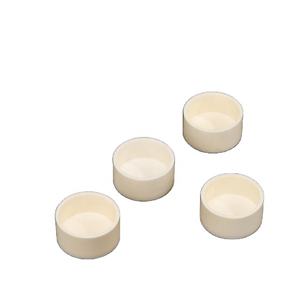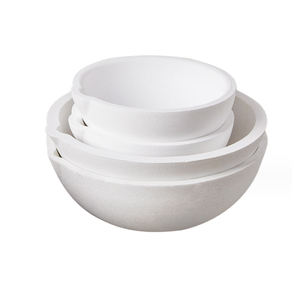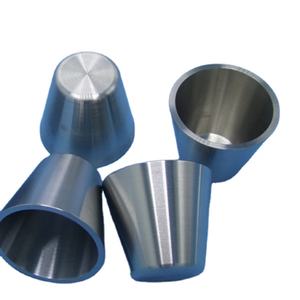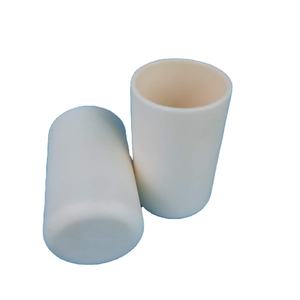Professional industry ceramic supplier, silicon nitride, silicon carbide, aluminum nitride and any other kinds of ceramics.
PRODUCT PARAMETERS
Description
Overview of Lab Melting Used Fused Silica Quartz Sio2 Ceramic Crucible
Lab Melting Used Fused Silica Quartz Sio2 Ceramic Crucible are specialized containers designed for withstanding extremely high temperatures in laboratory and industrial settings. They are essential for processes such as melting, calcining, and heat-treating a wide variety of materials, including metals, glasses, and chemicals. Our crucibles are engineered for superior thermal stability and chemical resistance, ensuring purity and reliability in the most demanding applications.
Features of Lab Melting Used Fused Silica Quartz Sio2 Ceramic Crucible
-
Exceptional Thermal Shock Resistance: Withstands rapid temperature changes without cracking, ensuring durability and a long service life.
-
High-Temperature Stability: Maintains structural integrity at extreme temperatures, often exceeding 1500°C.
-
Excellent Chemical Inertness: Resists corrosion and reaction with molten metals, acids, and aggressive chemical fluxes.
-
High Purity & Low Contamination: Manufactured from premium materials to prevent sample contamination during sensitive processes.
-
Optimized Thermal Properties: Designed for efficient heat transfer and consistent performance in furnace environments.
-
Robust Mechanical Strength: Offers good resistance to physical impact and abrasion during handling and use.
Specifications of Lab Melting Used Fused Silica Quartz Sio2 Ceramic Crucible
This fused silica quartz crucible handles extreme heat in the lab. It’s made from pure SiO2, over 99.99%. This means very few impurities. It stays strong at very high temperatures. You can use it continuously up to 1700°C. For short periods, it handles 1850°C. It resists sudden temperature changes well. This is important for melting and cooling cycles.
The material shows excellent chemical resistance. It doesn’t react easily with many acids or molten metals. This keeps your samples pure. It also has low thermal expansion. The crucible doesn’t grow or shrink much with heat. This prevents cracking under stress. The surface is smooth. This stops material from sticking. Cleaning is easier.
Different sizes are available. Common sizes are 10ml, 25ml, 50ml, 100ml, 250ml, and 500ml. Pick the size matching your sample amount. These crucibles work for melting glass, metals, and ceramics. They are good for ashing samples too. They are used in spectroscopy and high-temperature reactions. The fused silica is transparent to visible light and near-infrared. This allows visual monitoring of melts.
The crucible offers good electrical insulation. It provides strong mechanical strength at temperature. It withstands repeated use if handled carefully. Avoid thermal shock. Don’t heat or cool it too fast. Protect it from strong alkalis and hydrofluoric acid. These can damage the silica. Store it clean and dry. This crucible is a reliable tool for demanding high-heat work.
Applications of Lab Melting Used Fused Silica Quartz Sio2 Ceramic Crucible
People melt stuff in labs all the time. They need special containers. Fused silica quartz crucibles are important for this. They are made from very pure silicon dioxide. This material handles extreme heat well. It doesn’t crack easily when temperatures change fast. This is called thermal shock resistance. Chemical resistance is another big plus. These crucibles fight off strong acids. They fight off strong bases too. This makes them very tough.
Melting metals is a common job. People melt gold, silver, platinum, and other precious metals. They also melt aluminum and similar metals. Fused silica crucibles work well here. Glass making uses them too. People melt glass batches inside them. They fuse special glasses. Ceramic powder processing needs them. People calcine powders. They sinter materials. The crucible’s purity matters. It doesn’t add bad stuff to the melt.
High-tech fields rely on these crucibles. Semiconductor work uses them. People grow crystals. They purify materials for electronics. The crucible must be super clean. Research labs use them constantly. Scientists test new materials. They run experiments needing high heat. Fused silica crucibles are the go-to tool. They work in regular air furnaces. They work in vacuum furnaces. They work in induction furnaces. This versatility is key.
The crucible shape helps. Its smooth surface stops material sticking. This makes cleanup easier. The crucible lasts longer. People save money. Choosing the right crucible size matters. It depends on the material amount. It depends on the furnace type. Fused silica quartz crucibles are a lab essential. They handle the toughest melting jobs reliably.
Company Profile
Tanki New Materials Co.Ltd. focus on the research and development, production and sales of ceramic products, serving the electronics, ceramics, chemical and other industries. Since its establishment in 2015, the company has been committed to providing customers with the best products and services, and has become a leader in the industry through continuous technological innovation and strict quality management.
Our products includes but not limited to Aerogel, Aluminum Nitride, Aluminum Oxide, Boron Carbide, Boron Nitride, Ceramic Crucible, Ceramic Fiber, Quartz Product, Refractory Material, Silicon Carbide, Silicon Nitride, ect. please feel free to contact us.

Payment Methods
T/T, Western Union, Paypal, Credit Card etc.
Shipment Methods
By air, by sea, by express, as customers request.
5 FAQs of Lab Melting Used Fused Silica Quartz Sio2 Ceramic Crucible
Lab Melting Used Fused Silica Quartz (SiO2) Ceramic Crucible FAQs
1. What’s the highest temperature this crucible handles?
Fused silica crucibles manage very high heat. They work reliably up to 1100°C (2012°F). Pushing beyond this temperature risks damage. The crucible might soften or deform. Stick to the 1100°C limit for safety.
2. Can it handle sudden temperature changes?
Yes, fused silica resists thermal shock well. This means moving quickly between hot and cold is usually safe. It’s much better than regular ceramic crucibles here. Avoid extreme, rapid shifts whenever possible. This care extends its life.
3. How do I clean it after melting material?
Cleaning needs care. Let the crucible cool down completely first. Use warm water and a soft brush for basic residue. Stubborn material might need soaking in dilute acid. Avoid harsh abrasives or strong alkalis. These can scratch or damage the surface.
4. What materials can I melt inside it?
Fused silica works with many common lab melts. It’s good for precious metals like gold and silver. It handles various oxides and glasses too. Avoid materials containing strong alkalis or fluorides. These chemicals attack the silica surface aggressively.
5. How long will one crucible last?
Crucible lifespan depends heavily on use. Careful handling makes it last longer. Avoid extreme overheating or thermal shock. Avoid incompatible chemicals. Gentle cleaning helps. Expect many uses under normal conditions. Watch for cracks, cloudiness, or deformation. These signs mean replacement is needed.
REQUEST A QUOTE
RELATED PRODUCTS

High Temperature 1650 C Silicon Carbide Graphite Brass Melting Ceramic Crucibles

Economical Glazed Ceramic/Porcelain Crucibles with Glazing Lids High Wall Ceramic Crucible

Chemistry Lab Equipment Small Melting Ceramic Crucible Dish Cup Set Melting Gold Silver Copper Whip Tongs Handle

95% Alumina Ceramic Crucible Alumina Thermal Analysis Small Crucible With Lid

Pyrolytic Boron Nitride Crucible Pbn Ceramic Crucible Mbe Crucible



